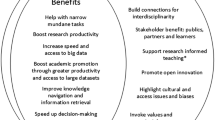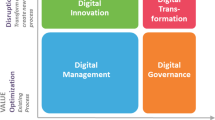Abstract
You should read this book if you identify with one or more of the following groups. The first group is the academic readership of The Journal of Technology Transfer, mostly organizational economists and policy analysts, who should read the book because it presents some compelling ideas for research and theory. The second audience is the journal’s policy making readership concerned with return-on-investment from universities, who should view the institutional design process touted by the authors with skepticism. The third audience is comprised of university administrators, who might be inspired by the book to reevaluate what they’re doing structurally at their own institutions.
Similar content being viewed by others
Notes
For example, these students may be excluded or selected-against once part of ASU and after, e.g., by dropping out of STEM majors and/or when applying for jobs or graduate school, respectively. Moreover, applicants accepted by universities with lower acceptance rates may opt for, say, Michigan or Harvard over ASU due to the prestige that accompanies attending a relatively selective university.
For example, the typical metrics for multidisciplinarity and related constructs (e.g., interdisciplinarity, transdisciplinarity), industry collaboration, and so on, may not be sufficient. Crow and Dabars clearly know the literature and understand well the landscape of US research universities, which warrants in-depth investigation of the institutional treatments at ASU to conceptualize and develop the appropriate constructs before comparing ASU to other research universities like Harvard and Michigan.
For example, addressing whether students at ASU who were or would be excluded from Michigan and Harvard are integrated into the research and transfer milieu at ASU begs for further analysis distinguishing different majors, cohorts, demographics, and so on.
The idea here is that egalitarian teams of faculty and administrators from different departments and different levels of the academic hierarchy are more likely to render teaching and science problem-focused rather than discipline-focused, inclusive rather than exclusive, and thusly more directly beneficial to society. And Crow and Dabars are probably right. The resolution of complex problems—for example in the areas of health, energy, and defense—historically have required multiple types of expertise, at different points of the innovation continuum, and from different economic sectors.
References
Boardman, C. (2014). The new visible hand: Understanding today’s R&D management. Issues in Science and Technology, 30(3), 23–26.
Boardman, C., & Bozeman, B. (2007). Role strain in university research centers. The Journal of Higher Education, 78(4), 430–463.
Boardman, C., & Bozeman, B. (2015). Academic faculty as intellectual property in university-industry research alliances. Economics of Innovation and New Technology, 24(5), 303–420.
Boardman, C., Gray, D., & Rivers, D. (Eds.). (2013). Cooperative research centers and technical innovation: Policies, strategies, and organizational dynamics of the new science and engineering management. New York: Springer.
Boardman, C., & Ponomariov, B. (2007). Reward systems and NSF university research centers: The impact of tenure on university scientists’ valuation of applied and commercially-relevant research. The Journal of Higher Education, 78(1), 51–70.
Bozeman, B., & Boardman, C. (2003). Managing the new multipurpose, multidiscipline university research center: Institutional innovation in the academic community. Washington, D.C.: IBM Endowment for the Business of Government.
Bozeman, B., & Boardman, C. (2004). The NSF engineering research centers and the university–industry research revolution. The Journal of Technology Transfer, 29(3–4), 365–375.
Bozeman, B., & Boardman, C. (2015). Research collaboration and team science: A review of the state of the art. New York: Springer.
de Solla Price, D. J. (1963). Little science, big science. New York: Columbia University Press.
Goodin, R. E. (Ed.). (1998). The theory of institutional design. Cambridge: Cambridge University Press.
Ponomariov, B. & C. Boardman. (2011). Organizational behavior and human resources management for public to private knowledge transfer: An analytic review of the literature. Paris: Organisation for Economic Co-operation and Development (OECD). Report 3 JT03317017.
Author information
Authors and Affiliations
Corresponding author
Rights and permissions
About this article
Cite this article
Boardman, C. Designing the New American University by Michael Crow and William Dabars: a primer for technology transfer academics, agencies, and administrators. J Technol Transf 41, 173–178 (2016). https://doi.org/10.1007/s10961-015-9437-4
Published:
Issue Date:
DOI: https://doi.org/10.1007/s10961-015-9437-4




